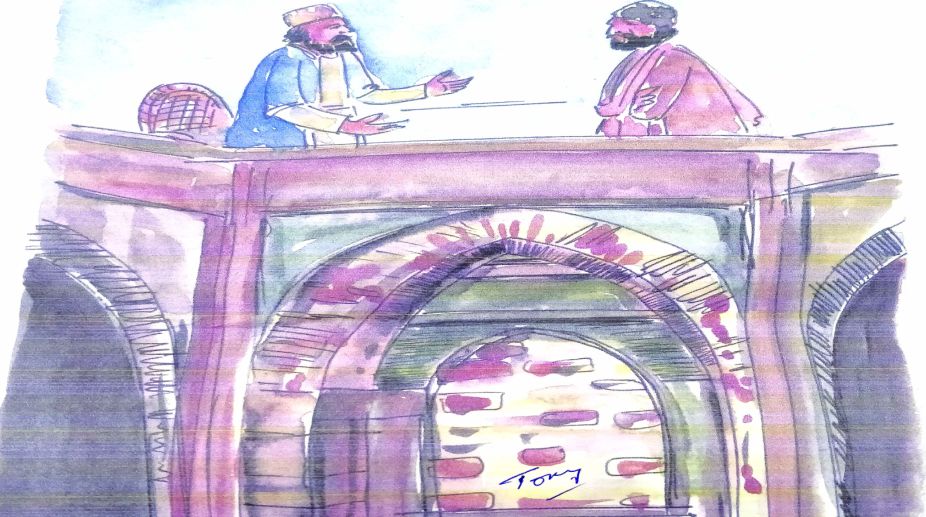Peacocks flaunting their feathers from the balconies of Chandni Chowk and Jaipur havelis will sound like a dream these days, though there was a time when it was a reality. Their feathers, however, still impact some colour to the footpaths of the Capital, notwithstanding the young princess, who had her “Swagh Raat” (wedding night) in a fanciful bed decorated with them and has become part of the saga of fashionistas.
Peacock feathers now are mostly in the form of fans and fly-whisks. Inquiries reveal that there is no large-scale slaughter of the National Bird to cater to the trade in feathers. The days when peacock pie was a common delicacy are numbered. The ban on shooting peacocks is rigidly enforced, and despite the allowance for clandestine trade, most of the feathers one comes across are from birds who died of natural causes, or feathers the birds discard seasonally.
Advertisement
There are hundreds of people in Rajasthan who collect peacock feathers and make a living through their sale, sometimes poisoning the National Bird.
However, the changed times have made a big difference: peacock feathers are not so highly prized as they used to be, especially in India. There are few indeed who care for them now that there are so many other items of decoration available.
For that matter, the men who sell the fans and the whisks in front of the Red Fort, Amber Fort and Hawa Mahal, confess that there has been a big fall in their earnings and sometimes they display the same fans for weeks. Having become wiser, they sell other trinkets, which make up for the loss in trade.
There are some who think that it is because of women’s lib that peacock feathers fail to attract the fair sex. It is the male bird after all which sheds them. Which truly liberated female would like to display such evidence of male superiority? Be that as it may, male vanity got a boost some time ago with Pierre Cardin’s prediction that floral shirts will be in fashion during summers as per the adage that fashion repeats itself.
Time was when kurtas embroidered with floral patterns and sherwanis were the craze of the elite in Jaipur, Delhi, Lucknow and Agra. However, with the advent of Western culture, kurtas went out of fashion for a while, though they were still worn at home. Since the attraction for kurtas got curtailed, the result was the emergence of the plain, drab, white shirt worn with trousers.
True to the French designer’s prediction floral kurtas and kurtis were soon in great demand, for besides being basically indigenous, they were certainly more eye-catching. It looked as though with re-emergence of the kurta, those days had returned when summer evenings rustled with kurtas crinkled by deft fingers in the zenana and even the moon seemed to blush at the delicacy of the female wearer.
Whether the tailors of the Metabruz area of Garden Reach, who have been carrying on their profession of Mughal times, through the Nawabi days and the British period to modern time, agree is a moot point. Mughal tailoring, which began in the days of Babar and Humayun, influenced Delhi, Agra and, later, Jaipur and Lucknow, from where it spread to the Nawabi of Bengal.
Many of the tailors are continuing their hereditary profession, with some vaguely remembering that their ancestors were attached to the court in the decadent period of the Mughal empire. That was when the sherwani craze had already begun to spread in preference to the traditional Angarkha of the old courtier.
Tailors began to learn new fashions and by the time of Bahadur Shah Zafar’s downfall the poets of Delhi had begun to parade in the streers of Chandi Chowk in their well-cut-sherwanis. Of course, they couldn’t vie with the “Bankas”, whose long moustaches and romantic gait were the envy of many a young man, like Nawab Buddhan, the fashion idol, whose haveli in Matia Mahal Street was the focal point of meeting for the well-dressed elite.
But talking of kurtas, one remembers of the one worn by Begum Akhtar, whose golden voice can still be heard sometimes at a music shop in Sadar Bazar, alive with that emotional intensity of thought and feeling, which went into every ghazal the queen of melody sang.
And judging from the response she gets from listeners, one finds it hard to believe that she is dead. Delhi was like a second home to this great exponent of Hindustani Music, and her admirers are to be found in every lane and gully of the city. And the residents of these areas still wear embroidered kurtas.
In summer one can buy ready-made onesin the Walled City as they are light to wear and help in keeping one cool. There are tailors who stitch them too in dingy shops, whose forefathers were employed by the memsahibs during the Raj days. No wonder the tailor, with spectacles on the tip of his nose, was a common sight in the old bungalows, like those of the Alexanders and De Silvas.
Power of gems
Where has all the treasure of the Mughals gone? There is no trace of it. but if you believe an old man, all that vast collection of gold and silver and precious stones was neither looted nor usurped by the British but pawned to the bullion dealers of Jaipur, Agra, Delhi and Lahore.
At least a substantial part of it, by the pauper Mughal kings and princes, who were, nevertheless, great believers in the power bestowed by precious stones, as were the Rajputs, many of whose women saved their honour from invaders and others who wanted to marry them, by swallowing the gems and dying.
The old man sometimes sits on a pavement in Ajmeri Gate with a glass case in which are rings, pendants, brooches, necklaces and precious stones. He hardly seems to get any customers. And the few that come out of curiosity go away with the proverbial flea in the ear.
The old man talks of precious stones as though they were genies entrapped by him for the well-being of his clients. You tell him your Zodiac sign and he will recommend the stone that will suit you best.
If your sign is Aries it’s a ruby for you, for Taurus it’s turquoise, for Gemini a topaz, for Cancer a pearl, for Leo a diamond for Virgo an agate, for Libra a sapphire, for Scorpio a bloodstone, for Sagittarius an amethyst, for Capricorn a garnet, for Aquarius an opal and for Pisces an emerald.
The diamond is a coloured or tinted brilliant stone of pure carbon, the colour of the ruby varies from deep crimson or purple to pale rose, The turquoise is opaque, skyblue or greenish blue, the topaz is transparent, yellow, white, green blue or colourless.
The pearl is white or bluish grey with a a beautiful luster, the agate is hard-banded chalcedony, the bloodstone is green chalcedony spotted or striped with red, the amethyst is purple or violet, the garnet transparent deep red, the opal milkwhite or bluish with green yellow and red reflections. The emerald is bright green and the sapphire transparent blue.
The old man describes the colours of each stone and their properties. Now Aries represents the Ram and the ruby is linked with it for protection and prosperity. Taurus, the Bull, is calmed by the turquoise stone. The Gemini twins, or Ashwini Kumars, love the topaz. Cancer, the crab prefers the pearl for it is not satisfied with anything less.
Leo, the lion, likes the hard diamond, which is as tough as it is. Virgo, the virgin, or kanya, merges with tile agate. Libra or scales balance with the sapphire, Scorpio the eternal scorpion, has its sting tied to the bloodstone, Sagittarius the archer, will have nothing but the amethyst. Capricorn, the goat chews the “sweet cud” of garnet. Aquarius, the water-carrier, loves the opal and Pisces, or fish, like to swim with emerald.
What happens if a Capricornian wears an amethyst? The old man shakes his forefinger. “He will lose his sense of judgement. An Aquarian may meet with an accident if he were to wear a bloodstone, a Leo would go soft in the head if his ring has an agate, a Geminian may become a pauper for sporting a ruby,and a Sagittarian will fall from grace if he wears an emerald, just as a Libran will become restless if he spurns the sapphire.”
One wonders at the word of the old man and his strong belief that imparts the halo of the Zodiac to the pavement. Now the Zodiac is the heavenly belt that includes all positions of the sun, the moon and the planets as known to the ancients and divided into 12 parts. The zodiacal light is the luminous triangular area of the sky seen at sunrise in the east and at sunset in the west.
R V Smith











